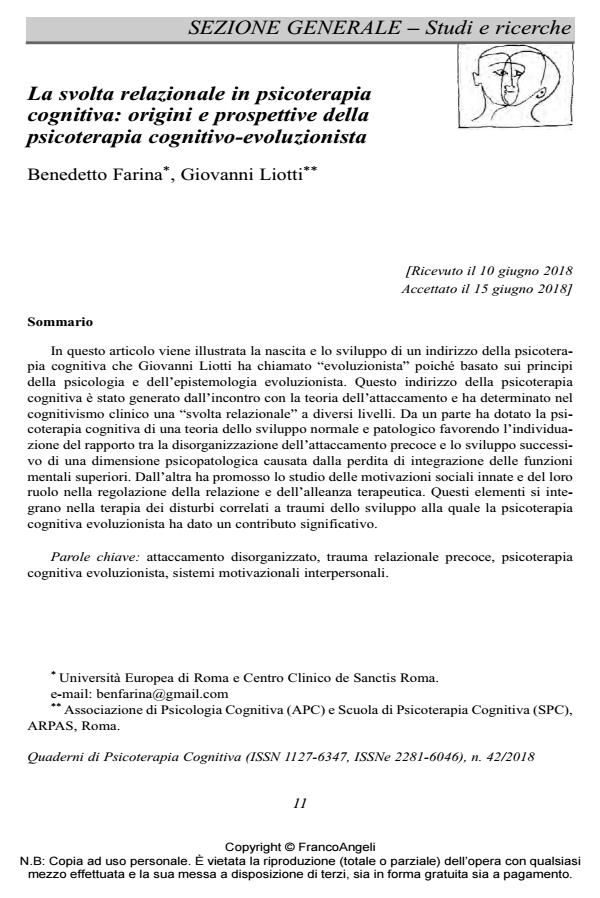The relational turn of cognitive psychotherapy: foundation and developments of evolutionist cognitive psychotherapy
Journal title QUADERNI DI PSICOTERAPIA COGNITIVA
Author/s Benedetto Farina, Giovanni Liotti
Publishing Year 2018 Issue 2018/42
Language Italian Pages 24 P. 11-34 File size 147 KB
DOI 10.3280/QPC2018-042002
DOI is like a bar code for intellectual property: to have more infomation
click here
Below, you can see the article first page
If you want to buy this article in PDF format, you can do it, following the instructions to buy download credits

FrancoAngeli is member of Publishers International Linking Association, Inc (PILA), a not-for-profit association which run the CrossRef service enabling links to and from online scholarly content.
This article describes the foundation and development of a cognitive psychotherapy approach called by Giovanni Liotti evolutionist cognitive psychotherapy because it is based on evolutionist psychology and epistemology. This approach emerges from the integration of attachment theory principles with cognitive behavioural therapy encouraging a relational turn. On one hand attachment theory provided a theory of normal and pathological development for cognitive psychotherapy. This favoured the discovery of the link between disorganized attachment and the psychopathological dimension characterized by failure of high integrative mental functions. On the other hand, evolutionist cognitive psychotherapy promoted the study of innate interpersonal motivations and their role in the regulation of therapeutic relationship. These two elements are integrated in the treatment of trauma related disorder for which evolutionist cognitive psychotherapy provided a significant contribution. Key words: disorganized attachment, early relational trauma, evolutionist cognitive psychotherapy, innate interpersonal motivations.
Keywords: Attaccamento disorganizzato, trauma relazionale precoce, psicoterapia cognitiva evoluzionista, sistemi motivazionali interpersonali.
- Dibattiti Saverio Ruberti, in PSICOTERAPIA E SCIENZE UMANE 3/2020 pp.471
DOI: 10.3280/PU2020-003009 - Il contributo delle ricerche del III Centro di Psicoterapia Cognitiva alla comprensione delle patologie della personalità Antonio Semerari, in QUADERNI DI PSICOTERAPIA COGNITIVA 42/2018 pp.65
DOI: 10.3280/QPC2018-042005 - The learning of specific dysfunctional behavioural patterns through social-network and telematics platforms in preadolescents and adolescents. Psychopathological clinical evidence Perrotta Giulio, in Open Journal of Pediatrics and Child Health /2021 pp.026
DOI: 10.17352/ojpch.000034 - Competenza tecnica e attitudinipersonali nel lavoro dello psicoterapeuta cognitivista Saverio Ruberti, Raffaella Visini, in PSICOBIETTIVO 1/2021 pp.113
DOI: 10.3280/PSOB2021-001012
Benedetto Farina, Giovanni Liotti, La svolta relazionale in psicoterapia cognitiva: origini e prospettive della psicoterapia cognitivo-evoluzionista in "QUADERNI DI PSICOTERAPIA COGNITIVA" 42/2018, pp 11-34, DOI: 10.3280/QPC2018-042002